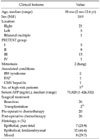1. Brown J, Perilongo G, Shafford E, Keeling J, Pritchard J, Brock P, et al. Pretreatment prognostic factors for children with hepatoblastoma: results from the International Society of Paediatric Oncology (SIOP) study SIOPEL 1. Eur J Cancer. 2000. 36:1418–1425.
2. Douglass EC, Reynolds M, Finegold M, Cantor AB, Glicksman A. Cisplatin, vincristine, and fluorouracil therapy for hepatoblastoma: a Pediatric Oncology Group study. J Clin Oncol. 1993. 11:96–99.
3. Atkinson JB, DeUgarte DA. Grosfeld JL, O'Neill JA, Fonkalsrud EW, Coran AG, editors. Liver tumors. Pediatric surgery. 2006. 6th ed. Philadelphia: Mosby;502–514.
4. Otte JB, Pritchard J, Aronson DC, Brown J, Czauderna P, Maibach R, et al. Liver transplantation for hepatoblastoma: results from the International Society of Pediatric Oncology (SIOP) study SIOPEL-1 and review of the world experience. Pediatr Blood Cancer. 2004. 42:74–83.
5. Pritchard J, Brown J, Shafford E, Perilongo G, Brock P, Dicks-Mireaux C, et al. Cisplatin, doxorubicin, and delayed surgery for childhood hepatoblastoma: a successful approach: results of the first prospective study of the International Society of Pediatric Oncology. J Clin Oncol. 2000. 18:3819–3828.
6. Aronson DC, Schnater JM, Staalman CR, Weverling GJ, Plaschkes J, Perilongo G, et al. Predictive value of the pretreatment extent of disease system in hepatoblastoma: results from the International Society of Pediatric Oncology Liver Tumor Study Group SIOPEL-1 study. J Clin Oncol. 2005. 23:1245–1252.
7. Zsíros J, Maibach R, Shafford E, Brugieres L, Brock P, Czauderna P, et al. Successful treatment of childhood high-risk hepatoblastoma with dose-intensive multiagent chemotherapy and surgery: final results of the SIOPEL-3HR study. J Clin Oncol. 2010. 28:2584–2590.
8. Sasaki F, Matsunaga T, Iwafuchi M, Hayashi Y, Ohkawa H, Ohira M, et al. Outcome of hepatoblastoma treated with the JPLT-1 (Japanese Study Group for Pediatric Liver Tumor) Protocol-1: a report from the Japanese Study Group for Pediatric Liver Tumor. J Pediatr Surg. 2002. 37:851–856.
9. Suita S, Tajiri T, Takamatsu H, Mizote H, Nagasaki A, Inomata Y, et al. Improved survival outcome for hepatoblastoma based on an optimal chemotherapeutic regimen: a report from the study group for pediatric solid malignant tumors in the Kyushu area. J Pediatr Surg. 2004. 39:195–198.
10. Meyers RL, Rowland JR, Krailo M, Chen Z, Katzenstein HM, Malogolowkin MH. Predictive power of pretreatment prognostic factors in children with hepatoblastoma: a report from the Children's Oncology Group. Pediatr Blood Cancer. 2009. 53:1016–1022.
11. Otte JB. Progress in the surgical treatment of malignant liver tumors in children. Cancer Treat Rev. 2010. 36:360–371.
12. Browne M, Sher D, Grant D, Deluca E, Alonso E, Whitington PF, et al. Survival after liver transplantation for hepatoblastoma: a 2-center experience. J Pediatr Surg. 2008. 43:1973–1981.
13. Cillo U, Ciarleglio FA, Bassanello M, Brolese A, Vitale A, Boccagni P, et al. Liver transplantation for the management of hepatoblastoma. Transplant Proc. 2003. 35:2983–2985.
14. Srinivasan P, McCall J, Pritchard J, Dhawan A, Baker A, Vergani GM, et al. Orthotopic liver transplantation for unresectable hepatoblastoma. Transplantation. 2002. 74:652–655.
15. Aretz S, Koch A, Uhlhaas S, Friedl W, Propping P, von Schweinitz D, et al. Should children at risk for familial adenomatous polyposis be screened for hepatoblastoma and children with apparently sporadic hepatoblastoma be screened for APC germline mutations? Pediatr Blood Cancer. 2006. 47:811–818.
16. Phillips M, Dicks-Mireaux C, Kingston J, Malone M, Mitchell C, Pritchard J, et al. Hepatoblastoma and polyposis coli (familial adenomatous polyposis). Med Pediatr Oncol. 1989. 17:441–447.
17. Thomas D, Pritchard J, Davidson R, McKiernan P, Grundy RG, de Ville de Goyet J. Familial hepatoblastoma and APC gene mutations: renewed call for molecular research. Eur J Cancer. 2003. 39:2200–2204.







 ePub
ePub Citation
Citation Print
Print



 XML Download
XML Download